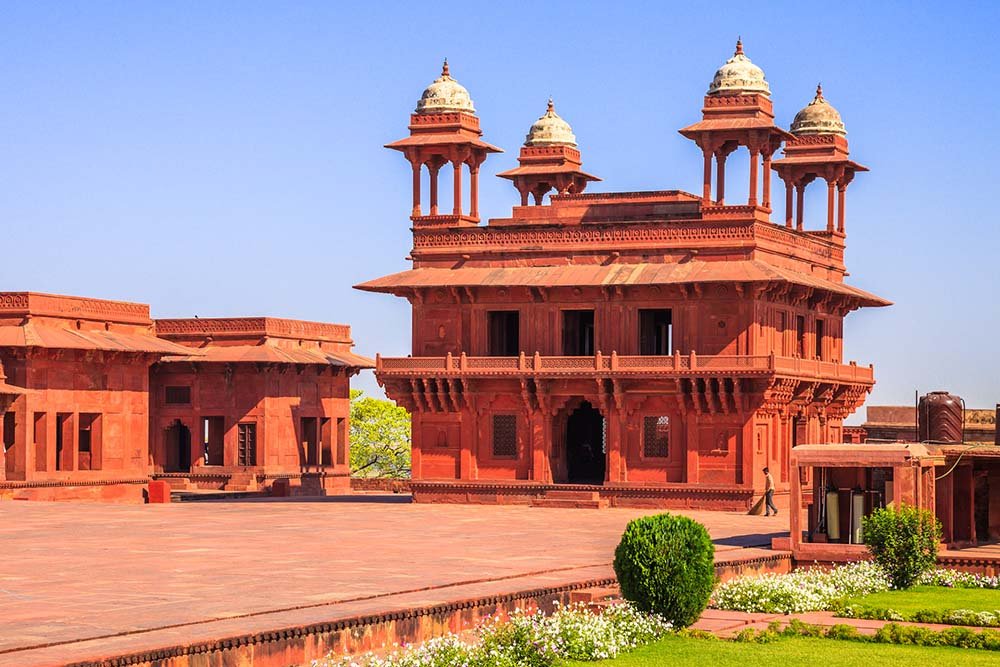The Best Things to See and Do in and Around Agra
Discover some of the best things to see and do when visiting Agra in India. Including the famous Taj Mahal, shows and places to dine.

Agra tops the list of most visited cities in India for travellers on a first-time trip to the country. But if you are looking for more than a rubber stamp trip, where you have a picture in front of the Taj and move on, it has numerous other historical attractions and exciting activities to enjoy whilst there. Here are some of the top things to do in the city to make your experience of Agra more memorable.
1. Visit the Taj Mahal
Standing majestically on the banks of the river Yamuna, the Taj Mahal is the most distinguished monument of India. This mausoleum is one of the seven wonders of the world, and a UNESCO world heritage site. Built by the Mughal emperor Shah Jahan in 1632 in memory of his wife Mumtaz Mahal, it has become a symbol of love and remembrance over the centuries. The perfection in symmetry, the intricacy of carvings and the detailing in marble inlay that was achieved in the Taj is the epitome of Mughal art and architecture.
The best time to see the Taj Mahal is either at the brink of the dawn when the white marble structure radiates in the golden morning or on a full-moon night when the moon beamed beauty transforms into different shades of blue with each passing hour. Taj Mahal is closed every Friday for the public.
See Tickets and Tours
2. Explore Fatehpur Sikri
The abandoned capital of the greatest Mughal emperor, “Akbar the Great”, is barely 37 km from Agra. Although it was built almost a century before the Taj, its architectural finesse is way ahead of its time.
Akbar was known for his religious tolerance, and his liberal political views are evident in his residential palace. The red sandstone palace is a perfect blend of many architectural styles. The Fatehpur Palace has an open plan with numerous terraces and pavilions. It was home to three queens of the emperor of different religions and faith. They were Turkish, Hindu, and Christian. Akbar had made their places according to the respective Queen’s taste.
The complex is segregated into two portions, the palace, and the tomb. The tomb belongs to Salim Chishti, the great saint Abkar worshipped. The entrance to the tomb is through a gigantic archway called the Buland Darwaza. Towering at 176 ft, it is one of the highest gateways in the world.
Fatehpur Sikri is open every day from 6 am to 6 pm. You can hire a guide who will escort you to the complex and explain in detail the history and facts but beware of the touts who partner with the guides trying to sell you handicrafts and other things. If you plan to buy anything, make sure you bargain from the asking price. It is not compulsory to make religious offerings anywhere unless you want to do it willingly.
You can also find tours to Fatehpur included as part of a package to see the Taj Mahal as well.


3. Enjoy chaat at Sadar Bazar
A trip to India is never complete without indulging in the delicacies served on the streets. Agra is no exception. The amalgamation of culture and heritage that was a legacy of Mughal rulers has transcended into the food scene of the city as well.
Most restaurants of the city serve the Mughlai cuisine, but the real gastronomical delight lies in the Chaat Gali of Sadar Bazar. The entire alley is full of stalls of sweet and savouries prepared fresh on the roadside. Aloo Tikki, Golgappas (Panipuri), Bhelpuri and Papri chaat are a few items to try in the chaat variety. Kulfi, Panchi petha, and Lassi are things to try for a sweeter tooth. The place is open all day, but it becomes lively in the evening when tourists and locals flock to shop and eat in this market.
ADVERTISEMENT
CONTINUE READING BELOW
4. Visit Jama Masjid
The Jama or the Jami Masjid is another noteworthy attraction in Agra. The mosque lies on the opposite side of Agra fort. Shah Jahan had built this mosque and dedicated it to his daughter. It is one of the largest and most revered mosques of India. The structure of the mosque is simple yet elegant. There is a central courtyard with a fountain. Make sure to climb on the minarets for a vantage point of the city. The mosque is free to enter, open every day, but is closed for non-Muslims at prayer time.
5. Explore Agra Fort
Agra had served as the residential city of Mughal rulers From Humayun to Shah Jahan, many rulers had contributed to the building of the Fort of Agra. On the banks of the river Yamuna, the fort is just minutes away from the Taj Mahal.
The fort has two marked entrances, Amar (Lahore) Gate and the Delhi Gate. The Delhi Gate adorns the same marble inlay work that is used in the Taj Mahal.
The Jahangir Mahal, Moti Masjid and Diwan- e-aam are some of the notable structures in the fort. The Diwan- I-Khas housed the most expensive and popular throne, the Peacock Throne, which was seized and taken to Iran in 1739. The Sheesh Mahal is another well-known structure inside the fort. The palace is decorated with mirrors on its walls and ceilings.
Since the distance between the Taj Mahal and Agra Fort is barely 2.5 km, you can combine visiting both these structures during the same day.
See Tours and Tickets


6. Visit the Keoladeo National Park, Bharatpur Bird Sanctuary
One of the finest bird habitats of the country is an hour’s drive from Agra. The Keoladeo Bird Sanctuary is in the city of Bharatpur. With more than 370 species of migratory and native birds, the park is a UNESCO world heritage site. Flocks of exotic birds migrate here for mating and nesting from across the globe.
The park is heaven for birdwatchers and nature photographers. Some of the fascinating fowls in the park are wagtails, pelicans, wheatears, and the rare Siberian crane. You can also spot wild animals such as jackals, sambar, and wild boar. Motorized vehicles are not permitted within the park. It is fun to explore on a rickshaw or bicycle.
If you want to get away from the chaos and bustle of Agra, this sanctuary is a perfect half-day getaway.
7. Enjoy dinner at Amarvilas
The Oberoi Amarvilas are one of the most luxurious hotels in the country. The nine-acre property is just minutes away from the Taj, and you can see it framed in almost every window of the property. Staying in Amarvilas is an expensive affair. But you can still admire the Mughal and Moorish interiors, the immaculate lawns, and fountained pavilions without splurging too much.
Book yourself dinner at Esphahan restaurant. The restaurant has live traditional music and candlelit tables. Or alternatively, you can grab a cup of coffee in its lounge. Besides coffee, the place also houses a French-influenced tea lounge and an Ottoman-style bar. The stylish and historic lounge features chandeliers, gold-domed ceilings and plush armchairs covered in cotton-silk brocade. If you are here for a special occasion, there is an option for a private dining experience. The candlelight dinner is served by the pool against the silhouette of the Taj.
8. Shop for marble inlay and leather goods
Mughal art has been known for its intricacy and craftsmanship. Parchinkari (or Pietra dura) is the technique of using cut gemstones on marble surfaces to create geometric or floral patterns. This form of art is ubiquitous to most Mughal buildings. Taking a souvenir back home of this art is one of the must-do things in Agra. You can choose from coasters, plates and vases that are easy to carry and available in most shops selling handicrafts.
Agra is also famous for its leather products. Sadar Bazar is a fine place to shop for both these things. Inside the Leather Wali Gali (an alley), there are shops selling shoes, sandals, wallets, handbags, and boots made of genuine leather. Make sure you bargain before making a final call for anything you shop here.
ADVERTISEMENT
CONTINUE READING BELOW
9. Watch a Mohabbat-e Taj show
The Taj Mahal is the proverbial crown of your Agra visit. To delve deep into the experience of the love story of Shah Jahan and Mumtaz Mahal, watch the Mohabbat-e-Taj show at the Kalakriti Cultural and Convention Centre. Besides showcasing a legendary love story, it gives a sneak peek of the rich heritage and culture of India. With more than 80 performers, extravagant sets, songs and dances, the style of the show is very Bollywood. To conclude the show, a scaled version of the Taj Mahal is dropped down on the stage with a hydraulic lift.
10. Relax at Mehtab Bagh
The Mughal rulers had built many gardens in India, beckoning their country Persia. These symmetrical, geometrical gardens had a design on the concept of their paradise and were called the charbagh.
Mehtab Bagh is also one of the Char Bagh. It was built by Emperor Babur and picked up by Shah Jahan later as a vantage point for viewing the monument. The crescent-shaped garden has fountains, pavilions, and pools. It is aligned in perfect symmetry with the Taj, and perhaps the least foot-trafficked point from where one can admire the marble wonder crowd-free. The place is open from morning to evening, and you can plan to spend a quiet time taking in panoramic views of the Taj in all its splendour.


Summary
Like most Indian cities, Agra is crowded. Start your day early to watch the Taj Mahal. It will help you to avoid both queues and traffic. The city of Agra has a large number of Muslim populations, dress in a modest fashion, with covered legs and shoulders to be respectful to the culture. Beware of scammers and avoid hiring unofficial guides. Most importantly go prepared and well researched as with any foreign country you are visiting. Read our tips on travelling to India.





